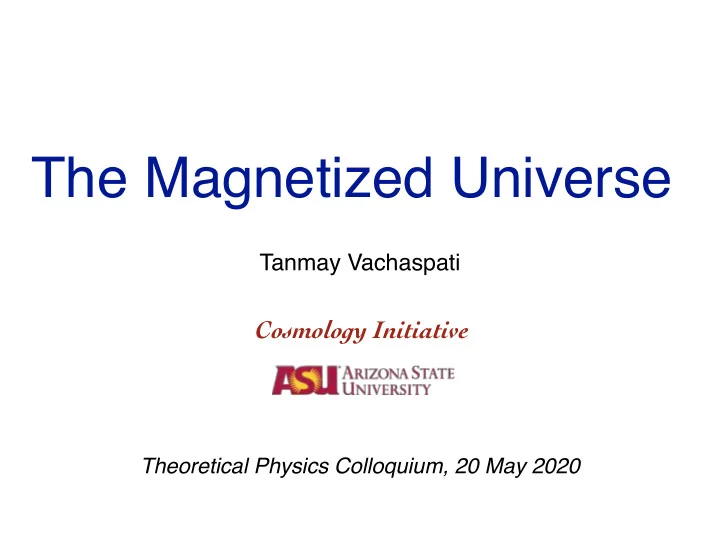

The Magnetized Universe Tanmay Vachaspati Cosmology Initiative Theoretical Physics Colloquium, 20 May 2020
Components Observations astrophysics; data Evolution MHD, 𝜓 MHD Early Universe standard model; extensions
Observations [many groups, many decades] Reviews by Kronberg; Widrow; Durrer & Neronov; Subramanian Galactic fields : primordial vs. dynamo (How to explain micro-Gauss fields in galaxies at z > 2?) Faraday rotation (quasars) : upper bounds of about a nano Gauss on coherent (Gpc) magnetic fields. BBN : Upper bounds at the micro Gauss level on energy density of fields . CMB : temperature anisotropies, B-modes. Upper bounds at the nano Gauss level on coherent fields. CMB : inhomogeneous recombination. (More later.) Blazars : lower bounds at the 10 -16 Gauss level on Mpc scales.
Observations: summary plot B 𝝾 BBN 💬 10 -6 G Quasars; CMB; UHECR… 10 -9 G 10 -15 G Blazars 𝝾 kpc Mpc Gpc Can explain galactic magnetic fields with minimal dynamo amplification. Several other constraints, e.g. structure of dwarf galaxies (Sanati et al, 2020).
Blazar Cascades Gould & Schreder, 1967; Coppi & Aharonian, 1998; ..... Neronov & Semikoz, 2009 TeV interior Morphology : GeV halo TeV EBL Spectrum : Depletion at TeV energies and excess at GeV energies. GeV B reduces shower contribution to spectrum. Flux GeV TeV HESS Credit: Nina McCurdy and Joel R. Primack/UC-HiPACC Energy
A Lower Bound Neronov & Vovk, 2010 Essey, Ando & Kusenko 2011 (and several other groups since) processed spectrum FERMI cascade primary bound (unabsorbed) spectrum Hess data missing GeV photons Fig. 1: A comparison of models of cascade emission from TeV blazars (thick soli
<latexit sha1_base64="SJgAP6X6RiMqkYAm7wlbrncY02U=">ACFHicbVDLSsNAFJ3UV62vqks3g0VwVRIp+FgV3bisYB/QxDKZ3rRDJ5MwMymU0N8Qt/od7sStez/DP3DSZmFbD1w4nHMv53L8mDOlbfvbKqytb2xuFbdLO7t7+wflw6OWihJoUkjHsmOTxRwJqCpmebQiSWQ0OfQ9kd3md8eg1QsEo96EoMXkoFgAaNEG+kpdcdA8e0UuwKw3StX7Ko9A14lTk4qKEejV/5x+xFNQhCacqJU17Fj7aVEakY5TEtuoiAmdEQG0DVUkBCUl86+nuIzo/RxEkzQuOZ+vciJaFSk9A3myHRQ7XsZeJ/XjfRwZWXMhEnGgSdBwUJxzrCWQW4zyRQzSeGECqZ+RXTIZGEalPUQofmvsR7wfEAo4izIdOcuNrJLWRdWpVa8fapX6Td5WEZ2gU3SOHSJ6ugeNVATUSTRC3pFb9az9W59WJ/z1YKV3xyjBVhfv1wenfI=</latexit> <latexit sha1_base64="dM0lYrUSv2JESUB3obAeFcHiz8=">ACEHicbVDLSsNAFJ3UV62vqks3g0VwVRIRfIBQdOygn1gG8pkctMOnUzCzKRQn9C3Op3uBO3/oGf4R84abOwrQcGDufcy7lzvJgzpW372yqsrK6tbxQ3S1vbO7t75f2DpoSaFBIx7JtkcUcCagoZnm0I4lkNDj0PKGd5nfGoFULBKPehyDG5K+YAGjRBvpKe2OgOLbyY3dK1fsqj0FXiZOTioR71X/un6EU1CEJpyolTHsWPtpkRqRjlMSt1EQUzokPShY6gISg3nV48wSdG8XEQSfOExlP170ZKQqXGoWcmQ6IHatHLxP+8TqKDSzdlIk40CDoLChKOdYSz72OfSaCajw0hVDJzK6YDIgnVpqS5FC8029iLuB8QCjiLMh05i40sk+Z1TmvXj2cV2rXeVtFdISO0Sly0AWqoXtURw1EkUAv6BW9Wc/Wu/Vhfc5GC1a+c4jmYH39AsLknJg=</latexit> Effect of a magnetic field TeV interior ~ B = 0 Morphology : TeV B GeV halo TeV interior EBL ~ B 6 = 0 CMB GeV GeV halo Missing GeV photons attributed to B > 10 -16 Gauss Plasma instabilities? Broderick, Chang & Pfrommer, 2012 HESS Credit: Nina McCurdy and Joel R. Primack/UC-HiPACC
Stacked Analyses Ando & Kusenko, 2010 Chen, Buckley & Ferrer, 2015 Hints for cascade photons from (stacked) sources. Pulsars (a) (b) FSRQs BL Lacs dN/d Ω (sr ) -1 (degree) (degree) (degree) (degree) θ (degree) θ (degree) (counts/sr) (counts/sr) FIG. 1. γ -ray counts maps of the stacked sources in the 1GeV- 1.58GeV energy bin. The large circles show the outer edge of dN/d Ω (sr ) the detection region. (a) Counts map of the 24 stacked low- -1 redshift HSP BL Lacs. (b) Smoothed counts di ff erence be- tween the stacked BL Lacs and the center-normalized stacked FSRQs. Positive values indicate the BL Lacs’ counts is greater than the FSRQs’. Halo detected at ~3.5 sigma. θ (degree) θ (degree)
Recombination with B Jedamzik and Abel, 1108.2517 Jedamzik and Saveliev, 1804.06115 Jedamzik and Pogosian, 2004.09487 Magnetic fields at recombination induce inhomogeneities in the baryon density on scales below the photon mean free path. Recombination rate is proportional to ⟨ n e2 ⟩ and is larger than ⟨ n e ⟩ 2 . Therefore magnetic fields induce earlier recombination and a reduced sound horizon r ∗ at recombination. This would shift the CMB spectral peak positions which are at 𝑚 p ∝ r ls /r ∗ unless last scattering surface is closer in, i.e. H 0 is larger.
Resolving the H0 tension with B 0 (slide provided by Levon Pogosian) 0 . 900 DES Planck Λ CDM 0 . 875 Planck+H3 M1 Planck+H3 M2 0 . 850 0 . 825 S 8 0 . 800 0 . 775 0 . 750 0 . 725 64 66 68 70 72 74 76 78 H 0 The baryon clumping parameter detected at ~4 s Corresponds to magnetic field strengths of ~0.05 nano-Gauss Also solves the mild tension in S 8 between Planck and DES K. Jedamzik and L. Pogosian, arXiv:2004.09487
Observations + spectra B 𝝾 BBN 💬 10 -6 G Quasars; CMB; UHECR… 10 -9 G baryon clustering 10 -15 G Blazars 𝝾 kpc Mpc Gpc Can explain galactic magnetic fields with minimal dynamo amplification.
<latexit sha1_base64="WlU75zDuPqRF0Pt6uyQ1AB9sztk=">ACe3icbVHbtQwEHVSLty28IjLyNWSAhVqwSKPBSyguPrcS2lTbLajJxWqu+RLZTsY3yof0MPgCBN5tKvTCS5eMzc2ZGx3klhfNJchnFa/fuP3g4WN949PjJ02fDzeHztSW+ISMNPY4R8el0HzihZf8uLIcVS75UX72bZk/OufWCaN/+EXFZwpPtCgFoQ/UfOia7JwT7LWQUWE8rJ6Zxlxi4LxQ3MFVzRfIArYKSFiqJdoMKhMucdF16/KZ0B6Kn+9/QbVC7+213vtfPhKBknXcBdkPZgxPrYnw9/Z4WhWnHtSaJz0zSp/KxB6wVJ3m5kteMV0hme8GmAGsPSs6Yzp4XgSmgNDacsFrHXlc0qJxbqDxUKvSn7nZuSf4vN619uTNrhK5qzWtBpW1BG9g6TQUwnLychEAkhVhV6BTtEg+/MeNKbkKasiNLEokDstRwaP0tiN3weG7cbo9/nSwPdr93Ls1YC/ZK/aGpewj2Xf2T6bMGKX7G80iNajP/EofhtvrUrjqNe8YDci/vAPifPAdw=</latexit> <latexit sha1_base64="SqfHnau8eTb5Flul4Xou6bW1Dr8=">AC3HicbVFdi9NAFJ3Er3X9qvroy8UiJsqWpBZdF4QFEfZFWMHuLnTSOJlM2mkmH8xMhDLkzTfx1V/miz/Df+C0zRZ31wsD57mXM0ktuNJB8Ntxr12/cfPWzu3dO3fv3X/Qe/joRFWNpGxMK1HJs4QoJnjJxprwc5qyUiRCHa5O9X9dOvTCpelZ/1smZRQWYlzgl2lJx7xcWpJwJBknMwTM4ySBvfZstpi/O0+c+YLnpegdYsEzDBHAmCTUf4o9e7rdmhGsO+XTYgodTJjSJDV+0ewbPibYKVnsLF+DS+CAWa24sDfYTtFCHotO86jT3N9qYslncw0ReEPL+dPXsFkyNd4rvz0/c297btzrB4NgHXAVhB3oy6O494fnFa0KVipqSBKTcKg1pEhUnMqWLuLG8VqQnMyYxMLS1IwFZm1+y08s0wKWSXtKzWs2X8nDCmUWhaJ7SyInqvLtRX5v9qk0dl+ZHhZN5qVdLMoawToClZfCSmXjGqxtIBQye2tQOfEWqjth1/YkhR2GpJKpBmhDFarEfhZUeugpPhIBwN3n4a9Q8POrd20BP0FHkoRG/QITpCx2iMqHPgfHG4s3Cn7jf3u/tj0+o63cxjdCHcn38BnjPgKA=</latexit> Origin of cosmological magnetic fields Several ideas : inflation; electroweak phase transition; QCD epoch; turbulence at recombination; astrophysics. All scenarios except inflationary magnetogenesis are “causal”. Description of stochastic, isotropic magnetic fields: Monin & Yaglom E M ( k ) H M ( k ) � 4 ⇡ k 2 ( � ij � ˆ k i ˆ (2 ⇡ ) 6 � (3) ( k � k 0 ) h b i ( k ) b ⇤ j ( k 0 ) i = k j ) + i ✏ ijl k l 8 ⇡ k 2 Power spectrum Helicity spectrum Z B · ~ ~ r ⇥ ~ d 3 x ~ A · ~ B ; circular polarization; B
Recommend
More recommend